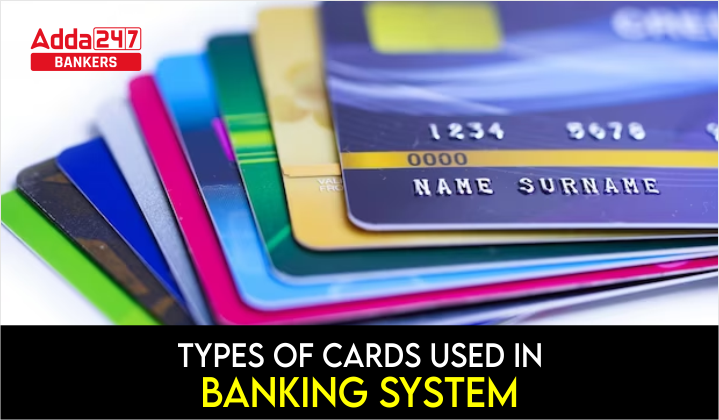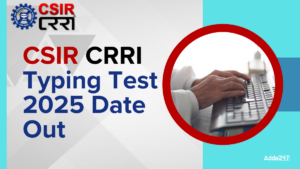In the banking sector, various types of codes are used for different purposes to ensure smooth and secure financial transactions. Card payments are an essential part of the payment system set up by banking institutions that offer hassle-free and cash-free options to make payments and also withdraw money as per the need of the cardholder. The cards like debit cards, credit cards, etc have eased the way banking transactions happen. The information on various types of cards and details on how they function along with differences among them are important for banking awareness. The space below has all the information on the Types of Cards Used in the Banking System.
Types of Cards Used in Banking Systems
Various types of Cards used in the Banking System are crucial in modern banking due to their convenience and ease of use. They provide a hassle-free way for customers to access their funds and make transactions without carrying cash. Cards are accepted globally, allowing for easy international transactions. They offer enhanced security with PINs and passwords, protecting against fraud. Here are the Types of Cards used in Banking System.
| Types of Cards used in Banking System |
|
| Debit Card | make payments from linked account |
| Credit Card | used to borrow money and make payments |
| Forex Card | to hold foreign currency during international travels |
| Prepaid Cards | load the money in advance and then make transaction |
| Electronic Cards | Electronic cards can be considered as debit cards issued in specific overdraft accounts that are in the nature of personal loan without any specific end-use restrictions. Banks have been permitted to issue electronic cards to natural persons having overdraft accounts so as to enable domestic digital transactions in such accounts. |
Debit Cards
They allow the cardholder to transfer money electronically from their bank accounts and can also be used as ATM cards to withdraw cash using the Automated Teller Machine. Keep in mind that you’re not borrowing money using a debit card, you are using the money deposited in the bank account linked to the card, whereas in credit cards, you borrow money to make payment
A deferred Debit Card allows the facility of payment to be done a few days later from the date of purchase.
Credit Cards
Credit cards allow the user to borrow money from the bank and make purchases. Bank or companies issuing credit card creates a revolving account and grants a line of credit to the cardholder, and then the user borrows money for payments or can also withdraw cash at times. Companies issuing credit cards also set a minimum repayment amount for the amount borrowed and also charge interest on delayed payments.
Following are some terms associated with credit cards-
- Credit Limit – represents the maximum balance on a credit card
- Balance – is the total amount you owe, including purchases, finance charges, and fees
- APR or Annual Percentage Rate– is the interest rate applied to the balance carried forward past the grace period of time.
- Grace Period – time alloted to pay your balance
- Credit Card Fees– annual or maintenance charges, late fee, and over-the-limit fee.
Forex Cards
Forex Cards stands for Foreign Exchange Cards and are used for international travels to hold foreign currency. There are two main variants- single currency cards and mlti-currency forex cards. Forex cards can also be used to withdraw the currency abroad.
Prepaid cards

Image Credit- rupay.co.in
Just as the name suggests in prepaid cards you can load the amount in advance and then use the money to make transactions, they are not linked to any bank accounts. The most common example is prepaid gift cards.
RuPay in India also brought prepaid cards in 2014 considering the huge opportunity in the untapped, unorganized, corporate gifting and other business space.
Electronic cards
Electronic cards can be considered as debit cards issued in specific overdraft accounts that are in the nature of personal loan without any specific end-use restrictions. Banks have been permitted to issue electronic cards to natural persons having overdraft accounts so as to enable domestic digital transactions in such accounts. For all purposes like security, Additional Factor of Authentication (AFA), Merchant Discount Rate (MDR), etc., the instructions relating to debit cards are applicable on such electronic cards as well.
What are various methods of using a card at a PoS terminal?
A card can be swiped (Magnetic-Stripe card), dipped (Chip based card) or tapped (Contactless Near Field Communication {NFC} Card) at a PoS terminal.
What are Magnetic Stripe cards, EMV Chip & PIN cards, and Contactless NFC cards?
Ans: The Magnetic Stripe card stores card data on the magnetic stripe present on the card while the data in EMV Chip & PIN cards is stored in a chip on the card. In a Contactless NFC card, the card is read by keeping the card near the card reader. The EMV Chip & PIN cards and Contactless NFC cards are considered to be safer when compared to Magnetic Stripe cards.
Have you heard about EMV Chip Card?
Well most of the cards now come with this technology of an integrated chip that adds a layer of security. EMV stands for Europay, MasterCard and Visa and EMV Cards are essential smart payment cards also known as IC cards. They prevent cloning of the card.
What are Card Present (CP) and Card Not Present (CNP) transactions?
A CP transaction is a card transaction that is carried out through physical presence of card at the point of transaction. It is also known as face-to-face or a proximity payment transaction. An example is a transaction carried out at an ATM or a PoS terminal. A CNP transaction does not require the card to be physically presented at the point of transaction. It is also called as a remote transaction. An example is an online transaction or a mobile banking transaction using the card.
Who decides the limits for cash withdrawal or purchase of goods and services through a card?
The limits on cash withdrawal at ATMs and for the purchase of goods and services are decided by the card issuer. Within these limits, the cardholder may set and modify transaction limits for various uses like domestic, international, PoS, ATMs, online transactions, contactless transactions, etc. Cash withdrawal using debit cards and full-KYC prepaid cards at PoS terminals has been allowed by Reserve Bank of India (RBI) whereby, a maximum of ₹2,000 can be withdrawn per transaction within an overall monthly limit of ₹10,000. Cardholders can check with their issuers for details of such facilities provided by them.
Details Mentioned on Different Types of Cards
The details on the card make the various cards different from others. The candidates must have all the information and understand the meaning of various details mentioned in different types of cards.
- Bank Name: Who has issued the card
- Card no: Normally they are 16 digits for online transactions. But they can vary from 14 to 19 digits.
- Card holders name: Name of the person in whose name card is issued
- Smart chips: Metal chip processor to avoid cloning
- Expiration date: Month and year is given till which it is valid
- Payment network logo: There are five payment networks current active in India- Visa, Mastercard, RuPay, American Express, and Discover.
RuPay is an Indian Domestic Payment system created by the National Payments Corporation of India. As per the official website rupay.in “It was conceived to fulfill RBI’s vision to offer a domestic, open-loop, multilateral system which will allow all Indian banks and financial institutions in India to participate in electronic payments.It is made in India, for every Indian to take them towards a “less cash” society.” Also note that banks are required to pay a quarterly fee for visa, master or foreign payment facilities whereas RuPay network is free of charge and is used only in India.
Details on The Backside of Cards
- Magnetic stripe: The black stripe contains all the information on the card
- Hologram: Additional security feature as its difficult to fake holograms.
- Security code: A CVV number is the acronym for Card Verification Value. It is required to complete transactions using cards, but along with that, it also provides added security against scam. it can be 3 or 4 digits. For Visa, Mastercard, Discover cards and Rupay cards, you will find that the CVV is a three-digit number. American Express cards have four-digit CVV numbers.
| Related Articles | |
| Deposit Insurance and Credit Guarantee Corporation | BASEL III Norms |
| Types of Bank Accounts | |





 Weekly Current Affairs One Liners 23rd t...
Weekly Current Affairs One Liners 23rd t...
 CSIR CRRI Typing Test 2025 Date for JSA ...
CSIR CRRI Typing Test 2025 Date for JSA ...
 Can Final Year Students Apply for SBI PO...
Can Final Year Students Apply for SBI PO...


